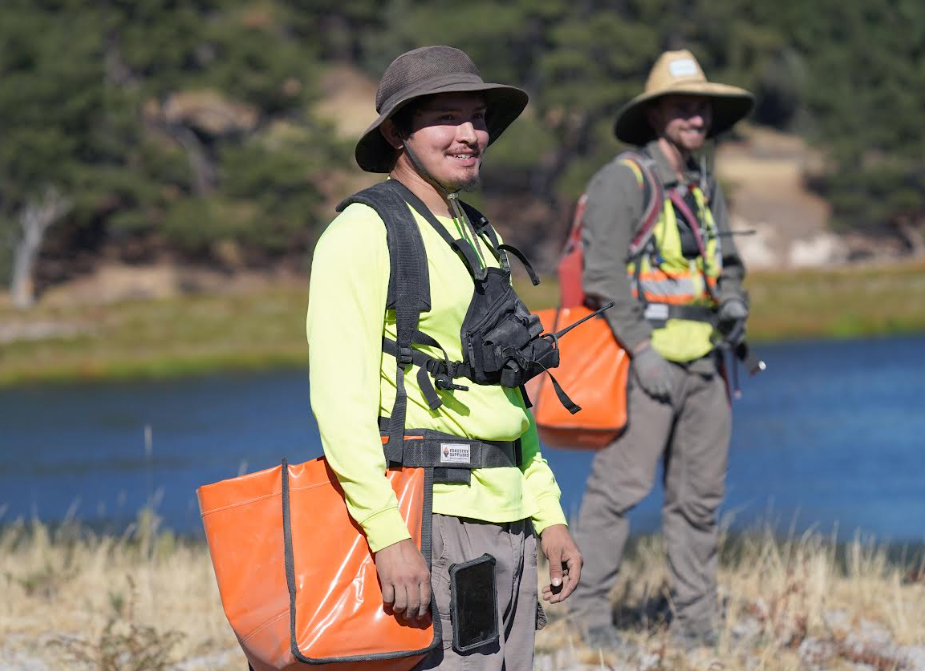
- Details
- By Native News Online Staff
Building on the success of the winter planting, the Yurok Tribe’s Fisheries Department has launched the second phase of a large-scale revegetation project along the recently restored river section, as salmon make their way to the Upper Klamath Basin for the first time in over 100 years.
The Yurok Tribe recently received $18 million from NOAA for the Upper Klamath River Tributary Post Dam Removal Salmonid Restoration Project. Focused on stream reaches outside of the reservoir footprints, the project seeks to restore Shovel Creek and sections of other tributaries between Jenny Creek in California and Spencer Creek in Oregon. The Yurok Tribe-led project will create approximately 150 acres of optimal fish and wildlife habitat through fish passage improvements, floodplain reconnection, side channel construction and stream habitat diversification. Currently, the Yurok Fisheries Department is working with four upper basin tribes and two conservation organizations to design the five-year undertaking.
This week, the Yurok Revegetation Crew, working under a contract with Resource Environmental Solutions, began hand-sowing millions of native plant seeds in the former J.C. Boyle Reservoir. A vibrant stretch of vegetation now lines the free-flowing river. The planting plan, crafted by Yurok Fisheries Department Senior Riparian Biologist Joshua Chenoweth, includes custom mixes of dozens of native plant species that once thrived along the Upper Klamath before the construction of dams and the onset of colonization.
“On the first morning, we saw an otter, eagles and waterfowl on the river’s edge. I wouldn’t be surprised if we see a few salmon move through there soon,” longtime Yurok Revegetation Crew member Ben Hunsucker, a Yurok citizen, said. “I know our ancestors are proud of the work we are doing on behalf of the river.”
The years-long revegetation effort aims to create biologically diverse ecosystems that support healthy populations of salmon, steelhead, and Pacific lamprey. The project is already showing promising signs, with much of the former reservoir now covered in soil-stabilizing vegetation, currently dormant due to the dry season. Native flowers planted over the winter bloomed from March to October, attracting pollinators that are helping to repopulate the area. Along the river, a band of green vegetation is alive with insects, which serve as an essential food source for young salmon, steelhead, and resident trout. Saplings of Oregon white oak, ponderosa pine, and Fremont cottonwood are taking root, along with perennial grasses like blue wildrye.
“I’m happy with the volume and diversity of healthy plants that we are seeing right now. It bodes well for the future,” said Chenoweth, who led the post dam removal revegetation work on the Elwha River before spending five years planning the Klamath project.
The in-river portion of the Klamath dam removal project was completed on October 2. The dams, which had caused a 95% decline in salmon populations by blocking 400 miles of historical habitat and degrading water quality, were a major obstacle for fish. The Yurok Tribe, along with other tribes in the Klamath Basin, fought for decades to remove the dams and restore the river. Last week, fisheries researchers observed the first salmon passing the former Iron Gate dam site.
In another positive development for the Klamath, the Yurok Tribe recently secured $18 million from NOAA for the Upper Klamath River Tributary Post Dam Removal Salmonid Restoration Project. This initiative will focus on restoring Shovel Creek and other tributaries between Jenny Creek in California and Spencer Creek in Oregon, creating roughly 150 acres of prime fish and wildlife habitat. The project, which includes fish passage improvements, floodplain reconnection, side channel construction, and stream habitat diversification, is being designed in collaboration with four upper basin tribes and two conservation organizations.
The tributary restoration will complement the ongoing revegetation efforts in the reservoir reach. In January, the Yurok team planted over 16,000 pounds of native grass, herb, and forb seeds throughout the area, along with 76,000 trees, shrubs, and grass plugs, 25,000 acorns, and 2,500 narrowleaf milkweed starts. The reservoir has since transformed into a landscape of blooming wildflowers, with species like Yellow Gum Plant still flowering alongside young pine trees near the former J.C. Boyle dam site. More planting is planned for next spring to continue revitalizing the area.
More Stories Like This
Klamath Indigenous Land Trust Purchases 10,000 Acres as Salmon ReturnTrump signs law that revokes some limits on drilling in Alaska’s National Petroleum Reserve
Southern Sierra Miwuk Nation Gets 900-Acres ofLand Back
Chilkat Indian Village Tells New Palmer Mine Owners They Are “Not Welcome” in Chilkat Valley
Tribes, Coastal Group Ask Army Corps to Revoke Permit for Texas Export Terminal
Help us defend tribal sovereignty.
At Native News Online, our mission is rooted in telling the stories that strengthen sovereignty and uplift Indigenous voices — not just at year’s end, but every single day.
Because of your generosity last year, we were able to keep our reporters on the ground in tribal communities, at national gatherings and in the halls of Congress — covering the issues that matter most to Indian Country: sovereignty, culture, education, health and economic opportunity.
That support sustained us through a tough year in 2025. Now, as we look to the year ahead, we need your help right now to ensure warrior journalism remains strong — reporting that defends tribal sovereignty, amplifies Native truth, and holds power accountable.
 The stakes couldn't be higher. Your support keeps Native voices heard, Native stories told and Native sovereignty defended.
The stakes couldn't be higher. Your support keeps Native voices heard, Native stories told and Native sovereignty defended.
Stand with Warrior Journalism today.
Levi Rickert (Potawatomi), Editor & Publisher


